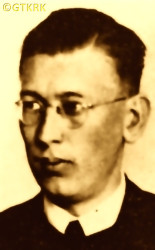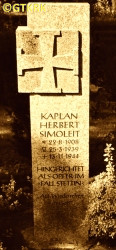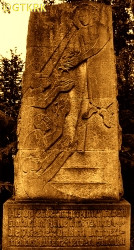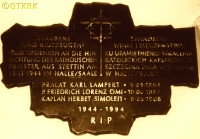Roman Catholic
St Sigismund parish
05-507 Słomczyn
85 Wiślana Str.
Konstancin deanery
Warsaw archdiocese, Poland
full list:
displayClick to display full list

searchClick to search full list by categories
wyświetlKliknij by wyświetlić pełną listę po polsku

szukajKliknij by przeszukać listę wg kategorii po polsku

Martyrology of the clergy — Poland
XX century (1914 – 1989)
personal data
religious status
Servant of God
surname
SIMOLEIT
forename(s)
Herbert
function
diocesan priest
creed
Latin (Roman Catholic) Church RCmore on
en.wikipedia.org
[access: 2014.09.21]
diocese / province
Berlin diocesemore on
en.wikipedia.org
[access: 2013.12.04]
nationality
German
date and place
of death
13.11.1944

Halle an der Saaleform.: Dobrogóra
today: Halle (Saale), Halle (Saale) dist., Saxony‐Anhalt state, Germany
more on
en.wikipedia.org
[access: 2022.08.05]
details of death
After German and Russian invasion of Poland in 09.1939 and start of the World War II during his weekly meetings with youth and soldiers talked about need to stop the war and discussed vast crimes perpetrated by the Germans, among others murders of Jews. The meetings were attended by an agent of the Germ. Geheime Staatspolizei (Eng. Secret State Police), i.e. Gestapo — an Austrian.
Arrested on 04‐05.02.1943 by the Germans in Szczecin, during „Fall Stettin” — action aimed at Catholic clergy — together with Fr Albert Hirsch, Fr Charles Lampert, Fr Friedrich Lorenz and Fr Alphonse Maria Wachsmann (arrested later), among others.
Held in Gestapo prison in Szczecin.
Interrogated numerous times and tortured.
Next brought to a prison in Berlin and from there, on 06.12.1943, transferred to Roter Ochse prison in Halle (Salle) where on 30.12.1943 tried by the highest military court Germ. Reichskriegsgericht (Eng. Reich Military Court), i.e. RKG, together with Fr Charles Lampert and Fr Friedrich Lorenz, accused of treason and sedition.
Found guilty but the lack of unanimity between the judges — only some voted for death penalty — the sentence was not signed.
Prob. on 14.01.1944 sent to German army Wehrmacht prison in Torgau.
On 28.07.1944 tried in Halle again, with the aforementioned priests, and again after a four–day trial found guilty of „undermining military morale and radio crimes”. Before however signing the death sentence, during the following night, presiding judge, Werner Lueben, committed suicide leaving a note stating that „These are neither 'criminals' nor 'asocial elements'. Their only tragedy is that they are Catholic priests!”.
Procedural errors led to third trial, on 08.09.1944 (or 02‐04.09.1944) in Torgau, when was sentenced to death — for the third time.
On 10.11.1944 brought to Roter Ochse prison in Halle and beheaded, together with two aforementioned priests.
cause of death
mass murder
perpetrators
Germans
sites and events
Fall StettinClick to display the description, Ribbentrop‐MolotovClick to display the description, Pius XI's encyclicalsClick to display the description
date and place
of birth
22.05.1908

Steglitztoday: locality in Berlin, Steglitz‐Zehlendorf borough, Berlin state, Germany
more on
en.wikipedia.org
[access: 2022.01.07]
alt. dates and places
of birth
08.05.1908
parents
SIMOLEIT Charles
🞲 ?, ? — 🕆 ?, ?

ROSINSKI Rosalie
🞲 ?, ? — 🕆 ?, ?
baptism
1912

Steglitztoday: locality in Berlin, Steglitz‐Zehlendorf borough, Berlin state, Germany
more on
en.wikipedia.org
[access: 2022.01.07]
Blessed Virgin Mary Queen of Holy Rosary RC church
presbyter (holy orders)
ordination
25.03.1939

Berlintoday: Berlin state, Germany
more on
en.wikipedia.org
[access: 2020.07.31]
St Hedwig of Silesia RC cathedral churchmore on
en.wikipedia.org
[access: 2019.10.13]
positions held
1941 – 1943
vicar — Szczecintoday: Szczecin city pov., West Pomerania voiv., Poland
more on
en.wikipedia.org
[access: 2021.12.18] ⋄ St John the Baptist RC parish ⋄ Szczecintoday: Szczecin city pov., West Pomerania voiv., Poland
more on
en.wikipedia.org
[access: 2021.12.18] RC deanery — also: local chaplain in the new pastoral region in the Braunsfelde Szczecin district (today Pogodno) and hospital chaplain
1939 – 1941
vicar — Greifswaldtoday: Vorpommern‐Greifswald dist., Mecklenburg‐Vorpommern state, Germany
more on
en.wikipedia.org
[access: 2022.02.15] ⋄ St Joseph RC parish — also: military chaplain at the Wehrmacht Greifswald base
c. 1938 – 1939
student — Berlin‐Grünaulocality in Berlin, Treptow‐Köpenick borough
today: Berlin state, Germany
more on
en.wikipedia.org
[access: 2025.04.13] ⋄ philosophy and theology, St Peter the Apostle Theological Seminary (in Hedwigshöhe building)
till c. 1938
student — Fuldatoday: Fulda dist., Kassel reg., Hesse state, Germany
more on
en.wikipedia.org
[access: 2022.06.29] ⋄ philosophy and theology, Theological Seminary
student — Wrocławtoday: Wrocław city pov., Lower Silesia voiv., Poland
more on
en.wikipedia.org
[access: 2021.04.02] ⋄ philosophy and theology, Theological Seminary
others related
in death
HIRSCHClick to display biography Albert, LAMPERTClick to display biography Charles, LORENZClick to display biography Frederick, WACHSMANNClick to display biography Alphonse Mary
sites and events
descriptions
Fall Stettin: German action against Catholic church in Szczecin and Pomerania region. Using provocation — among others German political police Gestapo disseminated rumours that Catholic priest allegedly installed broadcasting radio‐station on top the St John the Baptist church steeple and were secretly transmitting information to London — on 04‐05.02.1943 Germans arrested 40 people, including 11 Catholic priests, friars and nuns, accusing them of spying for allies. Some of the arrested were subsequently murdered (including five Catholic priests ‐ four of whom were tried, sentenced to death and beheaded in the prison), the rest were sent to concentration camps. (more on: pl.wikipedia.orgClick to attempt to display webpage
[access: 2013.05.19])
Ribbentrop‐Molotov: Genocidal Russian‐German alliance pact between Russian leader Joseph Stalin and German leader Adolf Hitler signed on 23.08.1939 in Moscow by respective foreign ministers, Mr. Vyacheslav Molotov for Russia and Joachim von Ribbentrop for Germany. The pact sanctioned and was the direct cause of joint Russian and German invasion of Poland and the outbreak of the World War II in 09.1939. In a political sense, the pact was an attempt to restore the status quo ante before 1914, with one exception, namely the „commercial” exchange of the so‐called „Kingdom of Poland”, which in 1914 was part of the Russian Empire, fore Eastern Galicia (today's western Ukraine), in 1914 belonging to the Austro‐Hungarian Empire. Galicia, including Lviv, was to be taken over by the Russians, the „Kingdom of Poland” — under the name of the General Governorate — Germany. The resultant „war was one of the greatest calamities and dramas of humanity in history, for two atheistic and anti‐Christian ideologies — national and international socialism — rejected God and His fifth Decalogue commandment: Thou shall not kill!” (Abp Stanislav Gądecki, 01.09.2019). The decisions taken — backed up by the betrayal of the formal allies of Poland, France and Germany, which on 12.09.1939, at a joint conference in Abbeville, decided not to provide aid to attacked Poland and not to take military action against Germany (a clear breach of treaty obligations with Poland) — were on 28.09.1939 slightly altered and made more precise when a treaty on „German‐Russian boundaries and friendship” was agreed by the same murderous signatories. One of its findings was establishment of spheres of influence in Central and Eastern Europe and in consequence IV partition of Poland. In one of its secret annexes agreed, that: „the Signatories will not tolerate on its respective territories any Polish propaganda that affects the territory of the other Side. On their respective territories they will suppress all such propaganda and inform each other of the measures taken to accomplish it”. The agreements resulted in a series of meeting between two genocidal organization representing both sides — German Gestapo and Russian NKVD when coordination of efforts to exterminate Polish intelligentsia and Polish leading classes (in Germany called «Intelligenzaktion», in Russia took the form of Katyń massacres) where discussed. Resulted in deaths of hundreds of thousands of Polish intelligentsia, including thousands of priests presented here, and tens of millions of ordinary people,. The results of this Russian‐German pact lasted till 1989 and are still in evidence even today. (more on: en.wikipedia.orgClick to attempt to display webpage
[access: 2015.09.30])
Pius XI's encyclicals: Facing the creation of two totalitarian systems in Europe, which seemed to compete with each other, though there were more similarities than contradictions between them, Pope Pius XI issued in 03.1937 (within 5 days) two encyclicals. In the „Mit brennender Sorge” (Eng. „With Burning Concern”) published on 14.03.1938, condemned the national socialism prevailing in Germany. The Pope wrote: „Whoever, following the old Germanic‐pre‐Christian beliefs, puts various impersonal fate in the place of a personal God, denies the wisdom of God and Providence […], whoever exalts earthly values: race or nation, or state, or state system, representatives of state power or other fundamental values of human society, […] and makes them the highest standard of all values, including religious ones, and idolizes them, this one […] is far from true faith in God and from a worldview corresponding to such faith”. On 19.03.1937, published „Divini Redemptoris” (Eng. „Divine Redeemer”), in which criticized Russian communism, dialectical materialism and the class struggle theory. The Pope wrote: „Communism deprives man of freedom, and therefore the spiritual basis of all life norms. It deprives the human person of all his dignity and any moral support with which he could resist the onslaught of blind passions […] This is the new gospel that Bolshevik and godless communism preaches as a message of salvation and redemption of humanity”… Pius XI demanded that the established human law be subjected to the natural law of God , recommended the implementation of the ideal of a Christian state and society, and called on Catholics to resist. Two years later, National Socialist Germany and Communist Russia came together and started World War II. (more on: www.vatican.vaClick to attempt to display webpage
[access: 2023.05.28], www.vatican.vaClick to attempt to display webpage
[access: 2023.05.28])
sources
personal:
niedziela.plClick to attempt to display webpage
[access: 2012.11.23], pl.wikipedia.orgClick to attempt to display webpage
[access: 2013.05.19], www.dioezesanarchiv-berlin.deClick to attempt to display webpage
[access: 2025.04.13], newsaints.faithweb.comClick to attempt to display webpage
[access: 2025.04.13]
original images:
www.gdw-berlin.deClick to attempt to display webpage
[access: 2019.04.16], staedtepartner-stettin.orgClick to attempt to display webpage
[access: 2019.04.16], commons.wikimedia.orgClick to attempt to display webpage
[access: 2019.04.16], docplayer.orgClick to attempt to display webpage
[access: 2019.04.16], pl.wikipedia.orgClick to attempt to display webpage
[access: 2013.12.04]
LETTER to CUSTODIAN/ADMINISTRATOR
If you have an Email client on your communicator/computer — such as Mozilla Thunderbird, Windows Mail or Microsoft Outlook, described at WikipediaPatrz:
en.wikipedia.org, among others — try the link below, please:
LETTER to CUSTODIAN/ADMINISTRATORClick and try to call your own Email client
If however you do not run such a client or the above link is not active please send an email to the Custodian/Administrator using your account — in your customary email/correspondence engine — at the following address:

giving the following as the subject:
MARTYROLOGY: SIMOLEIT Herbert
To return to the biography press below:
 Click to return to biography
Click to return to biography












